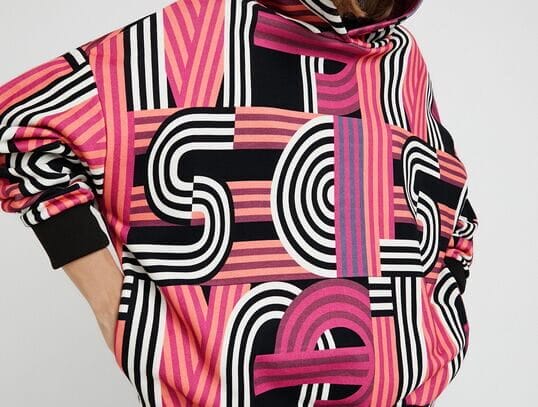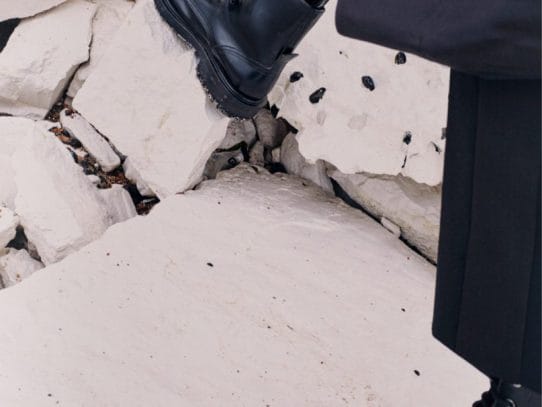JAKUB_TRAJTER_MEDUZA„Beware that, when fighting monsters, you yourself do not become a monster... for when you gaze long into the abyss, the abyss also gazes into you.” Friedrich W. Nietzsche
In the sphere of contemporary art, a new vanguard has emerged, each carving their unique path with extraordinary skill and profound expression. The new list of the ones-to-watch includes a sculpture artist with a distinctive voice and innovative use of fusing materials, which redefine the boundaries of sculpture art by transcending physical movement while being stable. Jakub Trajter is a name to remember as the force behind the new movement. As we explore these magnificent sculptures, it becomes evident that each piece carries its own unique narrative and aesthetic value.

Jakub Trajter’s innovative works redefine modern sculpture. His sculptures, primarily in metal, are expressive installations that command attention. Titled “Juxtapose, “this series of bronze sculptures by Jakub Trajter embodies the profound concept where chaos and order coexist within the realms of
physical manifestations. Meticulously crafted by hand, Trajter’s creation process is akin to a meditative practice, guiding him into a state of Zen. This journey to peace and tranquility serves as a tangible exploration to reflect the natural order of things in the universe. His sculpture is a testament to the human endeavor to recreate and rebuild amidst the constant presence of entropy – a fundamental
element of our existence.

In 2024, gallerists expect sculpture to become a significant trend in art collections and home interiors. These multidimensional works introduce a broad sense of movement and depth to a space. Although the future of art is uncertain, one thing is for sure: sculpture will flourish as long as artists are open to change and interested in the world. The way I see it, there will always be a wide variety of new and exciting pieces to enjoy as long as perspective exists.
As an art collector, selecting the right sculpture for your space can be a transformative experience, turning a simple room into a sanctuary of personal expression and beauty. My advice is to consider the space that reflects your aesthetic and understand the impact that it will bring into a space. Furthermore, it is always good to inquire about the materials durability and care requirements. And lastly, invest in pieces that will likely appreciate in value by understanding the history of the sculpture as well as the authenticity.

capturing emotionally charged situation Figures blend and overlap, defying the conventional laws of physics and anatomy.
Today, we are witnessing a new era in contemporary sculpture that defies expectations. Indeed, it is an exciting time within the innovative world of modern sculpture. Today, artists are redefining the art form with each new creation. With the power of new technologies and social media, the time is ripe for revolution -as artists delve into the realm where sculptures tell fascinating stories and on-trend artists push boundaries, offering a fresh perspective on three-dimensional expression. Stylelujo.com will guide you through the latest trends and groundbreaking works shaping contemporary art’s narrative today.
Through various forms, the art world is experiencing a renaissance that celebrates both tradition and innovation. Sculpture art is undoubtedly one of the art forms going through a transformative phase today as technology continues to shape and transform the creative landscape. New visionaries are enthusiastic about bringing unique perspectives, experiences, ideas, and emotions into their artwork, reflecting independent voices and using creativity.

As an enthusiast of contemporary sculpture artists, I am excited to review artist Jakub Trajter, a new kind of visionary who undeniably aims to shape the world of modern sculpture in the twenty-first century. Known for his large-scale sculptures that often reference modern culture, Trajter employs unconventional materials and techniques to explore new understandings of space and three-dimensional forms. His early works focused on realizations in marble, granite, bronze, and wood, emphasizing the surface and aura of forms. Transitioning to using metal waste, Trajter meticulously reworks materials to give them new shapes, delving beneath the surface to reveal his objects’ structure, layering, and inner energy. His expressive-dramatic sculptures range from stark constructivist assemblies to dynamic, baroque-like compositions, utilizing color and natural metal textures to accentuate fire marks and the passage of time. I find Trajter’s repertoire fascinating, which includes ships, cosmic shapes, futuristic city visions, trees, fantastical beasts, birds, monsters, and figures conveying timeless meanings. His latest work revisits the bronze solitaire, creating a “futuristic sculpture” concept that captures fleeting moments through multiple perspectives and evokes a sense of movement. His work blurs the boundaries between heritage and modernity and has achieved record-breaking recognition.

OLYMPUS DIGITAL CAMERA
Born March 11, 1983, in Bratislava, Slovakia, into a modest family, Trajter’s immense talent seemingly breaks conventional style codes, undoubtedly influencing future sculptors. Culminating in the harrowing and moving experimental areas, this new series marks a pivotal moment in Trajter’s career, where personal evolution and artistic expression converge. He studied at Josef Vydra School of Applied Arts, Bratislava, specializing in stone sculpture under the academic training of sculptor Vojtech Pohanke and graduated from the Academy of Fine Arts and Design in Bratislava, Department of Sculpture, under Prof. Juraj Meliš, focusing on sculpture, object, and installation.
Recently, the birth of his son introduced a new layer of complexity and inspiration to his work. Through engaging in the simple yet profound act of building blocks with his child, Trajter discovered a newfound appreciation for ‚playful destruction. This element of spontaneity and serendipity became a cornerstone of his creative process, allowing for an organic interplay between structured design and the unpredictable nature of creative destruction.

JAKUB_TRAJTER_MEDUZA„Beware that, when fighting monsters, you yourself do not become a monster... for when you gaze long into the abyss, the abyss also gazes into you.” Friedrich W. Nietzsche
often unseen aspects of our existence.
Jakub Trajter is a sculpture artist who stands out for his profound impact on the art world and public spaces. He is known for his dynamic art transformations through visionary sculptures. His bold use of form and materials brings new style and technique to the fore with concepts to life. Trajter’s work often features his distinct style and technique over time, drawing the viewer into a world where the viewer embarks on a journey through the world of a new destination for exquisite sculptures.
In 2024, the art of sculpture has evolved, becoming a key element in enhancing both personal and professional spaces. This artistic revolution offers diverse sculpturesthat resonate with contemporary tastes and timeless design. Upon viewing, I couldn’t help but observe how these pieces speak to your soul. Each piece is waiting to transform your environment and tell its unique story. Traitors’ sculpture not only occupies space but transforms it, inviting the viewer to contemplate and acknowledge our environment with a new perspective.
If the first quarter of the twenty-first century could be defined by one word, it would be experience. Overall, this groundbreaking transformation is redefining the art form while observing and experiencing present times by piquing the curiosity of art enthusiasts across the globe. Today, sculptors push the boundaries of materials, form, and concept by creating a fresh perspective reflecting our realities. As humanity evolves, so does the projection of our imaginations.
Don’t get me wrong, the new wave of contemporary sculpture will likely still be characterized by leveraging new materials and techniques with new innovative insight. The art form usually engages the audience by representing various voices and perspectives. But, the new era of sculpture will exhibit a new reveal in its conceptual depth, braced by rich thematic content that simultaneously interconnects the viewer by transforming the subject to a new actuality mirroring the influence of the latest technology in understanding the realm of a new era.
The artist has been building continuously on an interdisciplinary foundation that explores themes of the universe for almost a decade, which will put their relevant work on the radar of many more new audiences.
Traitor’s sculptures are more than just art pieces; they are expressions of culture, history, and personal taste. In sculpture art, incorporating a sculpture can transform an ordinary space into a gallery of individual expression. Traitor understands this transformative power and brings you on a journey that blends modern sculpture with various design aesthetics, adding a contemporary touch that often breathes an air of questionable elegance. Although the pieces cater to diverse tastes, the experience resonates with art collectors and viewers alike. Each sculpture is carefully selected to ensure it resonates with the collector, making their spaces more vibrant and personally meaningful.
Jakub Trajter’s work is multifaceted—spanning sculpture, but the artist’s recent series caught my attention. His work stands as a compelling narrative on the human condition, illustrating how the dynamics of entropy, order, and re-creation are not only essential components of the physical world but also integral to the human spirit. It is a reflection of life itself – complex, unpredictable, yet
undeniably beautiful in its continuous cycle of chaos and order, encouraging a deeper understanding of the delicate equilibrium.
Trajter’s powerful bronze sculptures, aptly titled Transformations, are a poignant representation of the human spirit’s unwavering yearning for freedom, exploration, and transcending the limitations of nature’s laws. His human figures gracefully transition between abstraction and realism, evoking a sense of fluidity and constant motion that mirrors the ever-changing nature of existence. With meticulous attention to detail, Trajter delves into the complexities of the human experience, exploring the intricate interplay between the physical and metaphysical, body and soul.
In recent years, Trajter’s penchant for interrogating newfangled forms of technology and the language of theory developing around them has pushed their work toward something more resembling conceptual art and digital activism.
Jakub Trajter’s distinct features and moderate fame make him an easy input for generative programs. Regarding individuals and how you want to present yourself online, As society develops and grows, art changes to reflect its new developments. Cultural progress and social change give momentum to the growth of art. Art is also essential as a symbol of culture around the world.

forms, the chains “dripping” to the ground describe the primary essence of
the universe, which is movement.
In his sculptures, Trajter eschews traditional portraiture to capture emotionally charged situations and the limitless possibilities of the mind. Figures blend and overlap, defying the conventional laws of physics and anatomy. Dynamic movements, accelerated and slowed, imbue the pieces with impermanence and intangibility.
They exist on the edge between the intimate inner realm and the external physical world, where the boundaries between the two blur. Through the powerful portrayal of physical and spiritual experiences, Trajter unveils new dimensions of ephemeral reality and invites viewers to delve deeper into the
often unseen aspects of our existence.
“Beware that, when fighting monsters, you do not become a monster… for when you gaze long into the abyss, the abyss also gazes into you.” Friedrich W. Nietzsche
The octopus has its starting point in steel pipes from my studio. The space served as a compressor room. Compressed air powered the entire factory, and I had to cut many steel distribution lines, which is where the inspiration came from. During the individual cuts, I realized what an inexhaustible shape resource the cylinder hides in itself. The simple shape of a cylinder hides
an infinite number of shapes.
The volume of the clouds in its geometric CLOUDS, 2015 essence is made up of triangular solid forms, and the chains “dripping” to the ground describe the primary essence of the universe, which is movement.
Futurism expressed great confidence in technical progress, including movement; it was concerned with the play of light and shadow, but in sculpture, Futurism also extended its interest to various intersections of the surrounding environment with the object. The author’s work Clouds is also ideologically
connected with futurism.
Save Article











